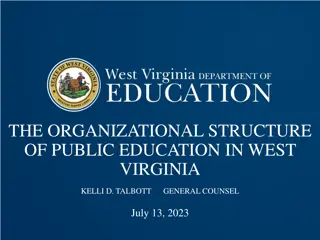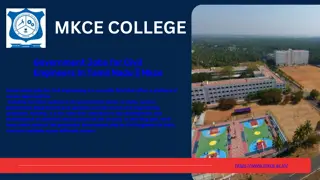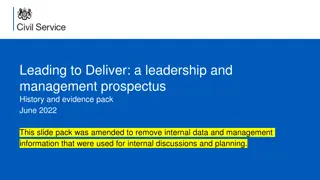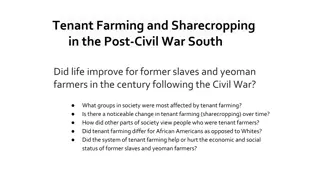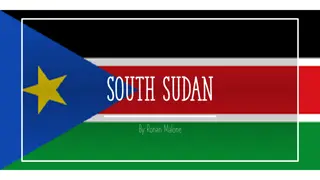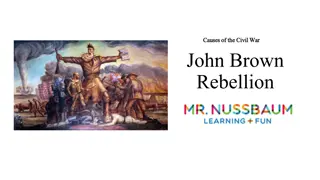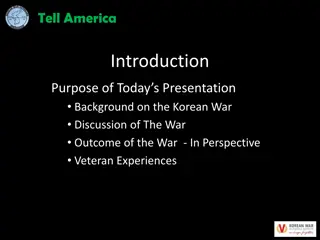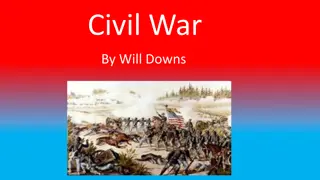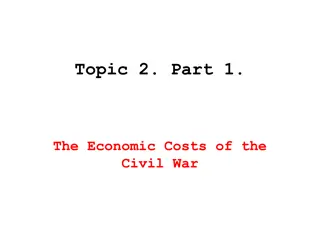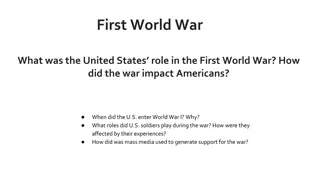Post-Civil War Experiences in the South and West
Explore the intertwined experiences of Black and Indigenous communities in the aftermath of the Civil War, shedding light on the challenges and conflicts faced in the South and West regions. Delve into the complexities of Reconstruction, the impact of the Civil War on Indigenous peoples, and the pressing questions surrounding freedom, citizenship, and peace in post-war America.
Download Presentation

Please find below an Image/Link to download the presentation.
The content on the website is provided AS IS for your information and personal use only. It may not be sold, licensed, or shared on other websites without obtaining consent from the author. Download presentation by click this link. If you encounter any issues during the download, it is possible that the publisher has removed the file from their server.
E N D
Presentation Transcript
Reconstruction South and West Black and Indigenous Experiences after the Civil War Dr. Erin Mauldin John Hope Franklin Chair of Southern History emauldin@usf.edu This Photo by Unknown Author is licensed under CC BY-SA-NC
The Civil War as Indian War Civil War, emancipation, and Indian wars all intertwined Emerge from conflicts over US westward expansion In the West, the Civil War a three- cornered conflict: US v. Confederacy v. Indigenous peoples
1862: Civil War battles increase in size and intensity, such as Shiloh, the Peninsula Campaign, and the Seven Days Battles; the Sioux Uprising begins in Minnesota; the largest mass execution in U.S. history occurs (38 Sioux men hanged) 1863: First African-American US regiments organized and used at battles like Fort Wagner; Lincoln issues the Emancipation Proclamation; U.S. Army commits the Bear River Massacre in Idaho which is then organized as a territory; Battles of Gettysburg, Vicksburg, and more turn the tide against the C.S.A.; Col. Kit Carson begins scorched earth fighting against the Navajo 1864: Battle of Atlanta and Sherman s March; Grant s Overland Campaign (Spotsylvania, the Wilderness, Petersburg); the U.S. Army s forced march of tens of thousands of Navajo prisoners (the Long Walk) begins as does their four-year imprisonment at Bosque Redondo; the Sand Creek Massacre of Cheyenne by U.S. troops; largest battle of the Plains Indian Wars at Adobe Wells (draw between Apache and U.S. Army)
A National Republican Vision Republicans in Congress pass laws intended to remake the nation before the war is over Many geared toward the West: USDA Transcontinental Railroad Homestead Act Morrill Act
Questions of Reconstruction In the South: How to protect ex-slaves freedom? Are they citizens? Should they be able to vote? How to reincorporate rebels? How to keep cash crop economy going? In the West: How to protect US territory and settlements? Can Indigenous people be citizens? How to maintain peace? How to civilize those on reservations?
Defining the legal and political standing of Black and Indigenous Americans Ensuring economic development in the South and West Supporting civilization (or community formation) in Black and Indigenous populations
Legal and political standing of Black Americans 13th Amendment Black Codes (packet) Civil Rights Act 1866 (packet) 14th Amendment Reconstruction Acts (packet) 15th Amendment
Legal and political standing of Indigenous Americans Civil Rights Act and 14th Amendment Department of the Missouri Sherman and Sheridan treat and war with Native Americans (packet) Doolittle Commission (packet) Indian Peace Commission (packet) Indian Appropriations Act of 1871 Indians wards of the state , US will not make treaties
Red Clouds War Snake War Cheyenne Expedition Great Sioux War 1868-9 1876 1864 1868 1866 1868 Caused by Sand Creek Massacre and Powder River Expedition during Civil War Guerrilla war between Paiute Shoshone & WA, CA, OR, ID vols Meant to quell unrest Led by Sitting Bull in response to violation of Treaty of Ft Laramie US Army expedition against Cheyenne under Sheridan Deadliest Indian war Last great gatherings of multiple nations on the Plains Lakota, Cheyenne, Arapaho, Crow Miners / wagon trains / squatters were cause Scorched earth campaign Able to protect Black Hills amid mining spree Included Battle of Little Bighorn Snake Indians raided NW reservations too Catalyst for changes to Indian Policy Inter-alliance fighting
Economic Development of the West Transcontinental Railroad Homestead Act (packet) Organized buffalo hunting Use of barbed wire Military protection of mining trails and sites
Economic Development of the South Plantation Bureau (packet) Field Order No. 15 (packet) Sharecropping and tenant agreements (packet) Bureau of Refugees, Freedmen, and Abandoned Lands Southern Homestead Act 1866 (packet)
Community Formation Republican policies promoted farming, male- led families, education, Christianity, civilization in both West and South Reaction very different according to region Policy toward Indigenous was much more reliant on force
Civilization in the South Black-led drive for community formation, establishment of religious and educational institutions, political apparatuses, and more Black ministers become leaders of the community, both socially and politically More than 3,000 schools in the South by 1869, many HBCUs like Fisk and Howard founded (packet)
Civilization in the West General Allotment Act, 1887 Divides up reservation land into individual plots; anything leftover sold off Attached citizenship to assimilation Included use of funds for Indigenous boarding schools


![❤[PDF]⚡ Civil War Talks: Further Reminiscences of George S. Bernard and His Fel](/thumb/20551/pdf-civil-war-talks-further-reminiscences-of-george-s-bernard-and-his-fel.jpg)
